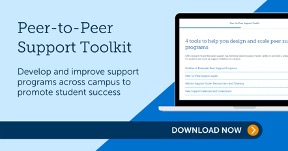It has been heartening in recent weeks to hear more conversation about the thorny challenge of student continuation and retention, particularly here on Wonkhe.
Students decide to drop out (or not drop out) of a course of study for any number of reasons. In some cases, particularly this year, that may be the right decision. But as I’m sure we can all agree, too often universities operate in ways that are detrimental to student continuation. It is lamentable when cumbersome processes, disconnected student records, and unclear roles and responsibilities to contribute to a student deciding to un-enrol.
A more serious understanding of and response to, student discontinuance may be one positive outcome of this year’s pandemic-related disruptions. In the US, where retention and continuation rates are much lower than in the UK, universities and colleges have found themselves addressing these issues for reasons rooted in both mission (it’s the right thing to do) and financial sustainability (it’s cheaper to retain a current student than to recruit a new one).
Regardless of the motivation, this year we have been seeing promising progress at the institutions we work with on both sides of the Atlantic. Just a few examples:
- Expansion of emergency grants: Alumni and others are contributing to emergency grant funds, and the distributors are becoming more strategic about when and how to deploy these grants to students for maximum impact.
- Enabling advisors and tutors with technology: Formerly passive advising offices are now aggressively reaching out to students to ensure that their needs are being met, and that they have the resources and skills to persist.
- Adoption of long-term degree planning: Advisors are working with students who withdraw from a course of study to create an academic plan that explains what a student would need to do to recover, re-enrol, and carry through to graduation.
- Redesigning problematic modules: Institutions are identifying modules with historically low completion and pass rates and turning those figures around with supplemental instruction, early warning alerts, course redesign, instructor swaps, and more. These modules often fared poorly in the transition to a virtual learning environment anyway.
You’ve got a friend in me
It has never been more important to be in touch with your students. Their physical, mental, and emotional health are at risk—and we are all trying to determine the best way to respond. Unfortunately, one obvious response—scaling up support with professional staff members—can be a financial challenge, especially in a difficult budget environment. If you find yourself in this situation, don’t overlook an effective partner already on campus: your own students.
A peer-to-peer support and advising programme utilises undergraduates as peer advisors to supplement the student support efforts of professional advisors. A peer advising team requires less financial investment and also builds a strong culture of support and belonging, especially among underrepresented students. These peer advisors serve the critical role of helping students feel more comfortable engaging with support. They can help to bridge the gap when the background and lived experiences of advisors differ from those of their students.
Peer-to-peer teams also create empowering on-campus student employment opportunities that have real community impact and career applicability. This practice is worth the investment as leaders shape their ongoing Covid-19 strategy—and it’s not too late to stand it up by the start of next term.
Don’t I know you?
As universities have launched peer-to-peer mentoring programmes on their campuses over the last few years, we have observed four attributes common among the most successful. We have collated in-depth case studies of each and access implementation resources here.
Peer support is offered to all students, not just those perceived to be at risk
Historically, universities have reserved high-touch initiatives for students deemed to have the greatest need. But these students may experience stereotype threat when singled out and resist support. And students who do not fall in a high-risk category must shoulder the onus themselves to seek out support. Instead, providing peer mentoring for all students helps scale success initiatives and promote a sense of belonging.
For example, at the University of Texas, all first-year students are placed into peer mentoring groups based on shared interests and undergo a common curriculum centred on student transition and the university experience.
Peer support begins at the point of matriculation
Time-strapped professional staff may struggle to provide in-depth support to first year students, who are busy learning the ropes of university life. Peers can better support the academic and social transition for new students, as the trust barrier is lower, and they can flag challenges requiring additional, professional support.
For example, the University of Windsor assigns peer mentors to required introductory modules within the Faculty of Arts, Humanities, and Social Sciences to develop academic skills and build a connection to the course of study.
Programmes are designed with the experience of both mentors and mentees in mind
Peer mentors are often promised they will see career benefit from participation in a mentorship scheme. However, universities who fail to deliver on that promise risk disengaging their mentors, impeding programme success. The best schemes provide their mentors with financial payment, educational credit, professional development opportunities, and even performance reviews.
For example, peer mentors at Marquette University undergo a certified training programme and can seek additional certifications, which equate to more compensation and a title change.
Interactive training prepares mentors for the full mentoring lifecycle
Programmes can get off on the wrong foot if training focuses on basic requirements and logistics of the programme, rather than the scope, boundaries, and role of a peer mentor. The best training offers two or more days of initial preparation, coupled with regular sessions throughout a term, to deal with the complexities that may arise during partnership.
For example, Queen’s University’s peer mentor training eschews administrative logistics for six core capabilities of mentors: mental health education, crisis response, resources and referrals, professional skills, health and wellness, and learning strategies.
Finally, some good news out of Washington
If those principles sound abstract, let me share with you one detailed example of a peer-to-peer support team in action. The heroes of the story work at the University of the District of Columbia (UDC), a primarily minority-serving institution in Washington, DC.
In early 2019, UDC hired ten undergraduates to form a peer advising team. Each student works about 20 hours per week; their responsibilities include answering basic questions for office walk-ins, promoting student support events, and creating videos and other resources to help students navigate university policies, procedures, and technologies.
Perhaps their most important responsibility is to supplement proactive advising. Peer advisors make up to 2,000 phone calls per term to remind students of important deadlines, assist them with basic registration issues, and direct them to relevant resources.
These outreach efforts are having a measurable impact at UDC. For example, late in the autumn term of 2019, UDC identified more than 300 students slated not to continue with their spring modules. Most of these students were having issues securing tuition payment, completing paperwork, and navigating administrative hurdles.
Peer advisors reached out to guide these students to offices and individuals that could offer immediate assistance. Their efforts resulted in 210 reinstatements, preserved more than $700,000 (£527,000) in tuition income, and made an estimated five per cent impact on overall retention from the autumn to spring terms.
We asked UDC’s student success leaders about their advice for anyone interested in creating a peer-advising team. Here are seven of their most important tips:
- Provide pre-written scripting for common issues
Don’t let inexperienced peer advisors “freelance” on these phone calls. Provide them with scripts for conversations about common issues, including guidance on when an issue needs to be escalated to a professional advisor or another support office. - Train peer advisors on any necessary compliance or legal issues
UDC requires peer advisors to complete training to ensure they are responsible and discrete with sensitive student information. - Employ accountability and data-gathering mechanisms
UDC configured its student information system to let peer advisors enter basic notes without exposing them to sensitive student information. This allows team managers to track progress and provides professional advisors with a more complete picture of students. - Pair peer advisors with professional advisors
As part of its pandemic response, UDC reorganised peer advisors so that each was paired with a professional advisor to form an outreach team. The peer advisor did initial outreach, assisted with scheduling, and handled basic questions. Complex issues were escalated to the professional advisor partner, who was ready to take the hand-off from live phone calls. - Hold candidates to high standards
Leaders at UDC look for candidates who have high critical thinking and problem solving skills but who are also motivated and have a customer service ethos. To ensure a continuity of quality of care, the same case scenarios used to interview professional advisors are used when interviewing peer advisors. - Ensure peer advisors represent a diversity of academic programmes
UDC recommends intentionally hiring peer advisors from a variety of academic areas in order to maximise breadth of expertise and avoid staffing issues brought on by midterm exams or major projects. - Frame the programme as a career development opportunity
UDC intentionally exposed peer advisors to experiences that translate well to the postgraduate job market. Peer advisors work on team projects, serve as a focus group for university decisions, conduct surveys and analyse the data, and regularly get opportunities to interact with senior leaders in order to build their professional confidence.
As you continue to work to improve student success and persistence at your institution, consider recruiting students to help bridge the gap and ensure a sense of support and belonging.
This article is published in association with EAB. For more guidance on how to develop peer-to-peer support and advising programmes, click the image below and download EAB’s Peer-to-Peer Support Toolkit.














I’m glad to hear people raising awareness for student mentoring! I recently embarked on a similar journey with a fantastic Mentor from http://www.lisnic.com and I wish someone had told me about this pathway back when I was a student.